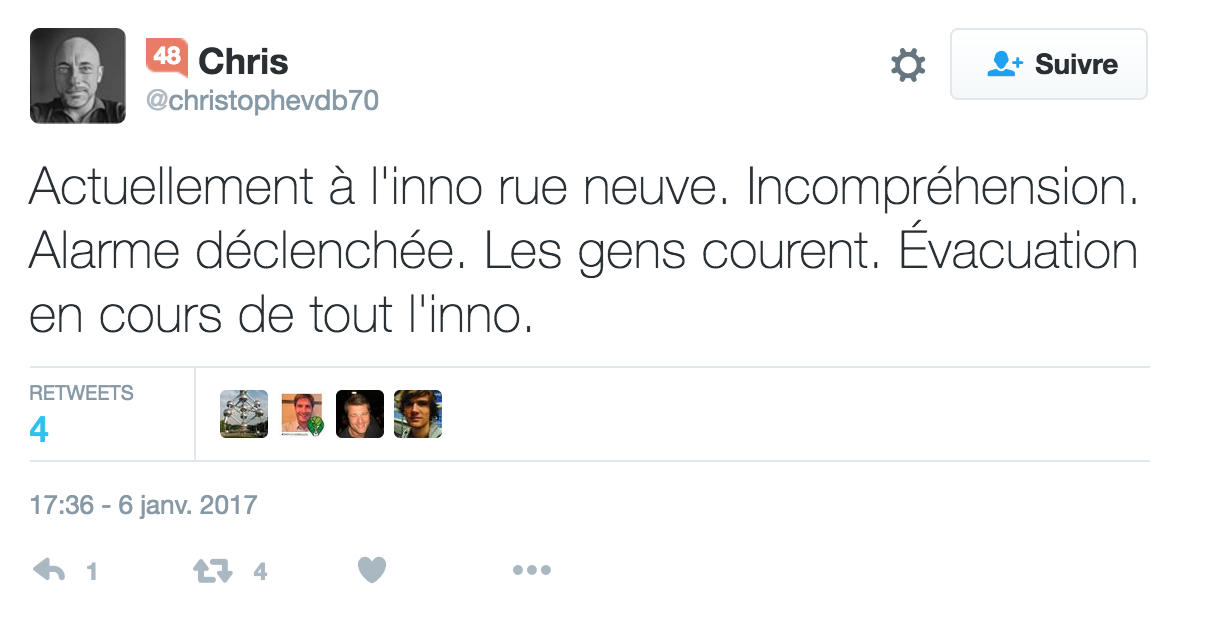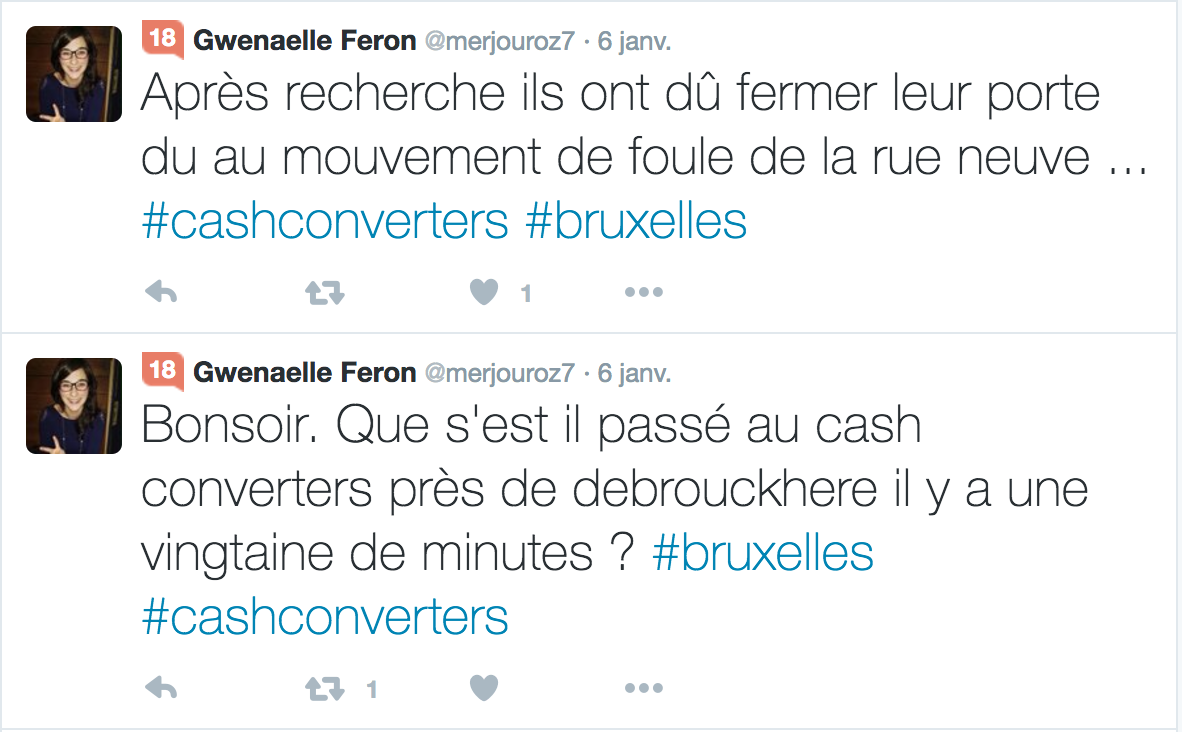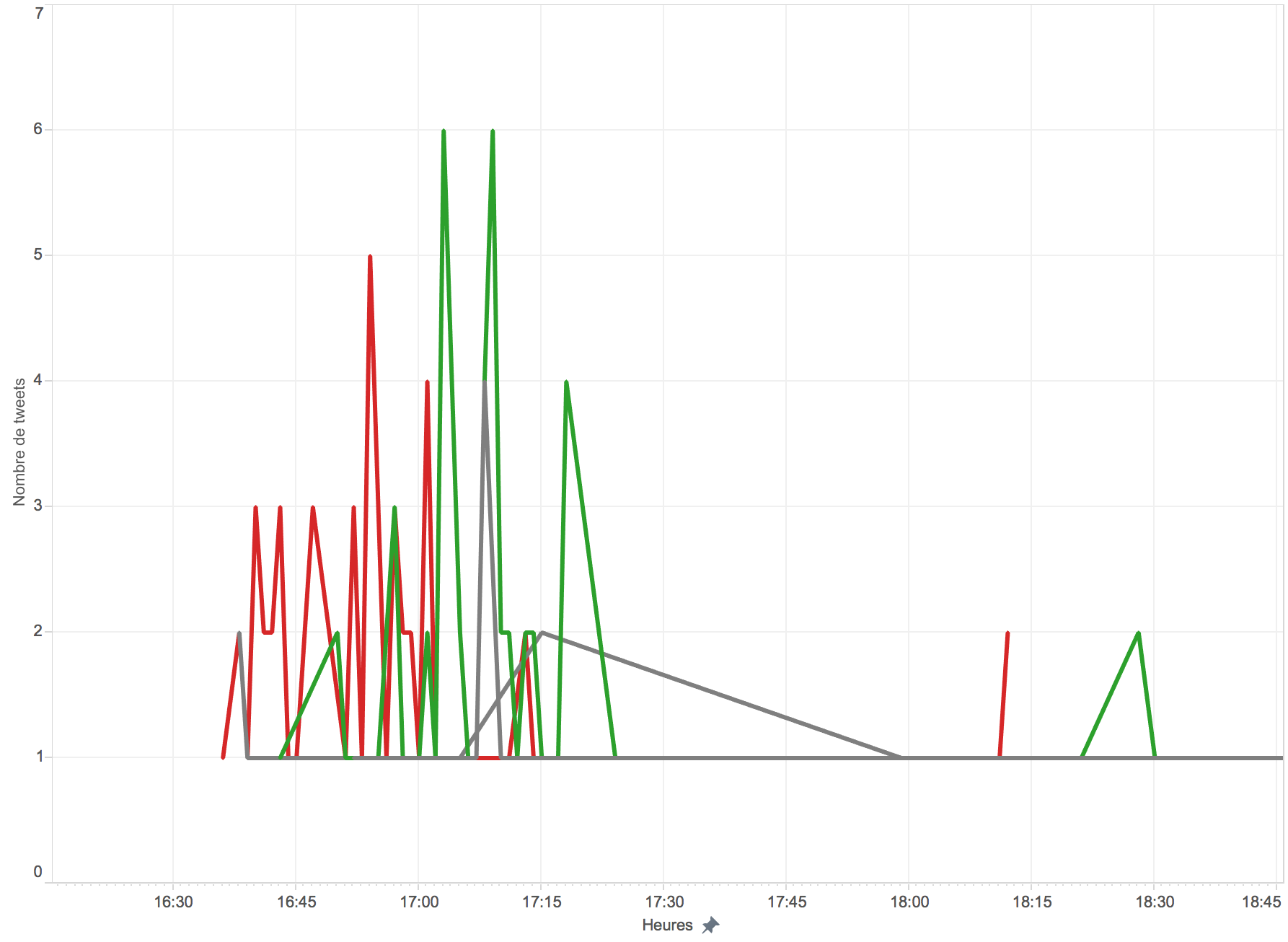Sommaire
Twitter coverage of the crowd movement in Rue Neuve (Brussels)

I. The story
The first tweet about the crowd movement came from a Brussels journalist, who announced only that there had been a crowd movement (unlike Juan-les-Pins, where an attack was announced). The second tweet also came from a journalist who spoke of panic:
The second tweet also came from a journalist who spoke of panic:
 Now it's time for questions:
https://twitter.com/wwwaltlowww/status/817408632623079425
The incomprehension of passers-by takes the form of tweets:
Now it's time for questions:
https://twitter.com/wwwaltlowww/status/817408632623079425
The incomprehension of passers-by takes the form of tweets:
 https://twitter.com/LudoBazuyn/status/817408926539018241
Then comes a first qualification of the origin of the crowd movement:
https://twitter.com/LudoBazuyn/status/817408926539018241
Then comes a first qualification of the origin of the crowd movement:
 This quickly raises questions:
This quickly raises questions:
 And a scenario can be set up, talking about a "mad gunman", confirmed by external elements (presence of a helicopter on the scene):
And a scenario can be set up, talking about a "mad gunman", confirmed by external elements (presence of a helicopter on the scene):
 https://twitter.com/Mael_Kbl/status/817411508489637888
External parties who are not on site:
https://twitter.com/Mael_Kbl/status/817411508489637888
External parties who are not on site:
 City 2 is evacuated:
https://twitter.com/BertremKathleen/status/817409552383705088
City 2 is evacuated:
https://twitter.com/BertremKathleen/status/817409552383705088
 The incomprehension is total:
The incomprehension is total:
 https://twitter.com/xureIie/status/817410305072529408
The first warnings are issued:
https://twitter.com/david_courier/status/817410756014669824
https://twitter.com/david_courier/status/817413000550293504
The first media is alerted:
https://twitter.com/rtlinfo/status/817410678323642376
And finally, the denial comes:
https://twitter.com/xureIie/status/817410305072529408
The first warnings are issued:
https://twitter.com/david_courier/status/817410756014669824
https://twitter.com/david_courier/status/817413000550293504
The first media is alerted:
https://twitter.com/rtlinfo/status/817410678323642376
And finally, the denial comes:
 However, not all networks have yet been reached:
https://twitter.com/VinceBillz/status/817411532942442498
https://twitter.com/GHulsens/status/817413211045691392
Others have no idea what happened:
However, not all networks have yet been reached:
https://twitter.com/VinceBillz/status/817411532942442498
https://twitter.com/GHulsens/status/817413211045691392
Others have no idea what happened:
 Le Soir was the first media outlet to give the full picture:
https://twitter.com/lesoir/status/817412932116107264
Then came the comments and people wondering what was going on:
https://twitter.com/AtgEiko/status/817413262564360192
https://twitter.com/LudovicVoet/status/817414037638152196
Le Soir was the first media outlet to give the full picture:
https://twitter.com/lesoir/status/817412932116107264
Then came the comments and people wondering what was going on:
https://twitter.com/AtgEiko/status/817413262564360192
https://twitter.com/LudovicVoet/status/817414037638152196
 https://twitter.com/erakor/status/817415318691778562
https://twitter.com/FannyCoppens/status/817416455906070528
https://twitter.com/erakor/status/817415318691778562
https://twitter.com/FannyCoppens/status/817416455906070528
 The rumours don't stop either:
The rumours don't stop either:

 This includes articles mentioning shootings when the rumour has been disproved:
This includes articles mentioning shootings when the rumour has been disproved:
 The authorities will also communicate:
The authorities will also communicate:
 But here again, this will not calm everyone down, nor will it quell the rumours:
But here again, this will not calm everyone down, nor will it quell the rumours:

 Eventually, a medical unit was set up, and the tweets are now almost exclusively from media outlets denying the rumour.
Eventually, a medical unit was set up, and the tweets are now almost exclusively from media outlets denying the rumour.
II. Analysis
- Analysis of rumour vs. denial
- Rumour
- Denial
- Comments
- Questioning

We can see that rumour invalidation occurs fairly early (you have to add an hour for real hours), but thatit takes more than 1 hour 45 minutes before the rumour is defeated. And there are still reminders of rumours in the form of retweets that pop up afterwards. If we take the retweets out of the equation, we see that the rumour is defeated much more quickly. (30 minutes) It's also worth noting that the curve for questions still largely follows the curve for denials, a sign that despite the denials, there are still people in doubt and waiting for answers.
 For the authorities and the media, this shows that it is not enough simply to disprove a rumour. You also have to monitor and respond to people who have questions.
2. ANS analysis
Of course, the media and authorities were the ones who gave the most coverage:
For the authorities and the media, this shows that it is not enough simply to disprove a rumour. You also have to monitor and respond to people who have questions.
2. ANS analysis
Of course, the media and authorities were the ones who gave the most coverage:
 The problem was that many of the media reported the crowd movement without giving the key to the solution. (Unlike Le Soir)
The problem was that many of the media reported the crowd movement without giving the key to the solution. (Unlike Le Soir)
III. Conclusion
We can take elements from our analysis of the Juan-les-Pins crowd movement:- On Twitter, there is always some truth behind the rumour. A firecracker, a crowd movement, a gathering of police officers, and so on. In this case, that was the case because there were a lot of eyewitness accounts and something was actually happening.
- The rumour was then spread by people who were not there. Questions from people who weren't there, wondering what was going on, "Twitter journalists", and prevention messages urging people to stay at home. Here again, relatives not on site asking for information on Twitter, questions spreading rumours, and so on. We've also had "Twitter info" accounts that simply relay that something is happening, but without giving any information, because they're not on site.
- The rumour will then always have a modification, a diversion. A firecracker becomes an explosion, then a shoot-out. A gathering of CRS becomes a hostage-taking, etc. Similarly, we have heard of shootings, a bomb, a mad killer, etc. The rumour is confirmed by witnesses.
- The rumour is confirmed by outside evidence. (Police on the scene, helicopter in the sky, shop closing, etc.).
- Once the rumour has been disproved, it quickly dies out. In fact, it does die out. But 1 hour 45 minutes later if we take into account retweets and only 30 minutes for normal tweets. This shows the logic of the timeline and the communitisation of information. Saying that you are a media outlet or an authority is not enough to put a stop to rumours.
- Disproving a rumour is always more visible than the rumour itself. This is because those involved in disproving the rumour always have a higher profile (media, authorities) than those spreading the rumour. However, the problem is that this visibility does not always reach the actors who are in possession of false information. This is because the communities of actors are different.




